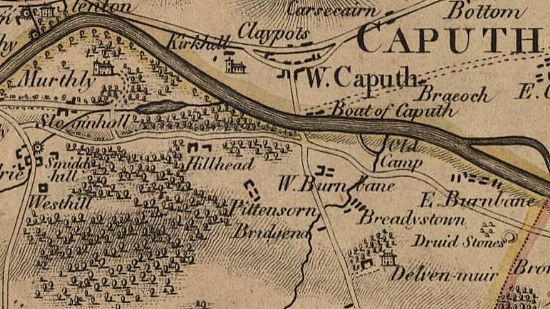Give Stobie Some Credit
Added on 06 March 2019

Step forward James Stobie (1775 - 1804) factor to the Duke of Atholl, surveyor and, more importantly for us, mapmaker.
He published his 'The Counties of Perth & Clackmannan' in 1783. In which he maps the 'Druid Stones', quite precisely as a circle of five. Without recourse to the surveying mechanics and equipment available to the trained engineers working for the Ordnance Survey, he gets it right.
Or does he? Some people now take issue with aspects of Stobie's work, questioning his veracity and technique. For example, he marks settlements that others, such as Adair, Roy, Thomson and Knox don't seem to know of. Places such as Breadystown, Delven-muir and the Old Camp. With this track record they say, something like stippling in five dots could just be a coincidence.
Take the Old Camp, which he shows as the area immediately where the Gellyburn meets the Tay. Never a stone nor spear point, neither pot nor lintel, nothing has ever been turned up there to suggest settlement. It's a fancy. And what of Delven-muir, a mansion no less. By no means as big as the House of Murthly, but a sizeable building. Of which no one knows anything. (Interesting that Stobie alone of cartographers of this period seems not recognise Murthly as a castle, but then he is factor to the Duke of Atholl, kens the difference between, castle, great house, palace and mansion.)
Well, his critics are probably right about the Old Camp. And, in a way, so very wrong. Stobie would have been working from his own measures, moving across the land, counting buildings in each settlement, stones in each circle. And listening to the inhabitants; many of whom he would have known. There's your difference in number of fermetouns and settlements mapped, and their names. Unlike those other mapmakers he knows this land; it's home. He knows the stories, tales and legends.
A few years later, in1793, the Reverend Mr John Robertson of the parish of Little Dunkeld responds to the demand of Sir John Sinclair (1754-1835) to help compile the 1st Statistical Account of Scotland, parish by parish. In a footnote Robertson mentions the existence of a 'military entrenchment' about a mile downstream from the House of Murthly on the south bank of the river that, although ancient, still has parapets and a deep ditch some 600 feet long. 'This work was probably executed to guard a pass upon the Tay which is fordable at this place.' Could it be that Stobie and Reverend Robertson are drawing upon the same third party source? Something everyone locally takes to be gospel? What then should a local mapmaker do?
Today a geologist might argue that these parapets are no more than the original bank of the Tay, from soonish (geological time) after the last Ice Age, when the river was considerably wider and very much deeper. You can at least inspect the Old Camp, where the Gellyburn meets the Tay and decide for yourself.
Stobie may have only incorporated local knowledge (for which read folklore). When James Knox maps the area in 1850 for his ' Map of the basin of the Tay, including the greater part of Perth Shire etc'. And depicts the area as the 'Camp'. Is he following precedent, or plagiarising?
Knox has his uses. He is going to help settle another of the calls on Stobie's competence. That of Delven-muir. It's hard now to turn up any evidence for a sizeable building at that time, at the spot indicated. Strike one against Stobie. Although working to a smaller scale, with correspondingly less space for detail, Knox nevertheless maps a 'New Delven', in roughly the same area. It turns out that in Stobie's time the small estate of Delven-muir belonged to the Mackenzie family across the river. Then in 1820 Sir George Stewart of Grandtully, Strathbraan, Murthly and Airntully flexes his financial muscle and buys the estate. Which shows up as 'New Delvine' in legal documents. It's a complicated land transaction involving a bit of excambion and hard cash. In other words Sir George, somewhat over keen to swallow this bubble preventing him from owning all the land from Birnam Hill to the edge of Stanley, gives up some of the land he owns near Delvine on the north side of the Tay, and a pile of siller, to acquire New Delven. We swap things on Gumtree: They excambion.
The land stays on the Murthly estate books as New Delvin for another twenty years, appearing as such in the beautiful estate plan drawn by James Chalmers in 1825, where there clearly was intended a fine big house. It is also listed in the first national census of 1841. Today we know it as Bradystone House. That's right. When Sir George's second son, William, (who inherits in 1838) eventually stamps his authority as laird he pushes through a name change, adapting an old name for the area . . .Breadystown.
Oh, and on the matter of the other set of Druid Stones in the area mapped by Stobie, near Essendy , he draws the correct number of stones there too, and the road to Blairgowrie that runs right through the middle of them. Easier to see today if you cycle to them than from a car.